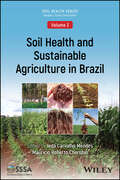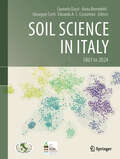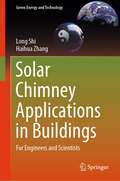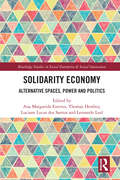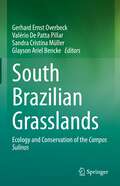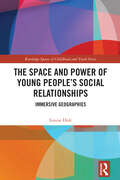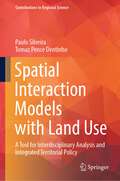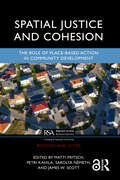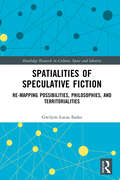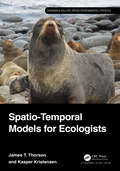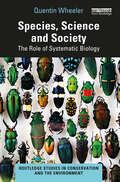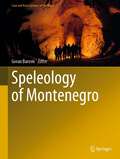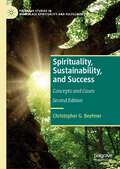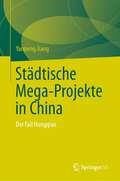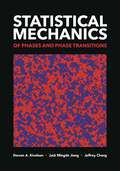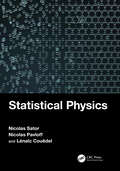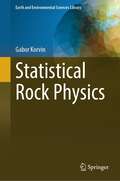- Table View
- List View
Soil Health and Sustainable Agriculture in Brazil (ASA, CSSA, and SSSA Books)
by Ieda Mendes Mauricio R. CherubinSoil Health and Sustainable Agriculture in Brazil A far-reaching survey showcasing the improvements made to soil health in Brazil The maintenance of healthy soil resources provides the foundations for an array of global efforts and initiatives that affect humanity. Researchers, consultants, and farmers must be able to correctly examine and understand the complex nature of this essential, fragile resource. Soil Health and Sustainable Agriculture in Brazil provides a highly readable overview of the major cropping systems and management practices adopted in Brazil to improve soil health and sustain agricultural/forest production systems. Key Features Evolution of soil health concepts applied to modern agricultural systems in Brazil. Overview of the major cropping systems and management practices adopted in Brazil to improve soil health (SH) and sustainability of agricultural production. Challenges to manage soil health in new agricultural frontiers. Presentation of SoilBio Technology: inclusion of soil enzymes as part of routine soil analyses (SoilBio Technology) and calculation of Soil Quality Indexes (SQI) Public policies and initiatives to promote SH and carbon sequestration in Brazil. Soil Health and Sustainable Agriculture in Brazil is ideal for soil scientists, agronomists, and any other researchers in both academia and industry interested in building a sustainable future.
Soil Health and Sustainable Agriculture in Brazil (ASA, CSSA, and SSSA Books)
by Ieda Carvalho Mendes Maurício Roberto CherubinSoil Health and Sustainable Agriculture in Brazil A far-reaching survey showcasing the improvements made to soil health in Brazil The maintenance of healthy soil resources provides the foundations for an array of global efforts and initiatives that affect humanity. Researchers, consultants, and farmers must be able to correctly examine and understand the complex nature of this essential, fragile resource. Soil Health and Sustainable Agriculture in Brazil provides a highly readable overview of the major cropping systems and management practices adopted in Brazil to improve soil health and sustain agricultural/forest production systems. Key Features Evolution of soil health concepts applied to modern agricultural systems in Brazil. Overview of the major cropping systems and management practices adopted in Brazil to improve soil health (SH) and sustainability of agricultural production. Challenges to manage soil health in new agricultural frontiers. Presentation of SoilBio Technology: inclusion of soil enzymes as part of routine soil analyses (SoilBio Technology) and calculation of Soil Quality Indexes (SQI) Public policies and initiatives to promote SH and carbon sequestration in Brazil. Soil Health and Sustainable Agriculture in Brazil is ideal for soil scientists, agronomists, and any other researchers in both academia and industry interested in building a sustainable future.
Soil Science in Italy: 1861 to 2024
by Carmelo Dazzi Anna Benedetti Giuseppe Corti Edoardo A.C. CostantiniHistory is generally defined as “the study of past events, particularly in human affairs” and is mostly understood when presented chronologically. That’s why someone also defined it as the ‘chronological record of the past’. Knowing the past is extremely important for any society and human being. Past gives us insights into our evolving behavior in many matters of life. The book is seen as a unique opportunity to preserve the memory of the Italian history of soil science. It represents a milestone and a cultural heritage. Moreover, the book is a sort of ideal bridge between the pioneers of soil science in Italy and the young generation of researchers, contributing to spreading awareness of the importance of soil as a fundamental resource.
Solar Chimney Applications in Buildings: For Engineers and Scientists (Green Energy and Technology)
by Long Shi Haihua ZhangThis book comprehensively describes the operating principles and theoretical foundations of solar chimneys. It covers current research results, including numerical analysis and mathematical models based on different assumptions. Complying with the application of renewable energy in sustainable buildings, solar chimney has received extensive attention as an indispensable part natural ventilation. This book is a guide to the application of solar chimneys from single zones to multi zones, and it provides a reference source of application for construction practitioners and engineering decision-makers. The design basis and the related basic principles of fluid mechanics and natural ventilation design strategies introduced in this book will also be beneficial to college students.
Solidarity Economy: Alternative Spaces, Power and Politics (Routledge Studies in Social Enterprise & Social Innovation)
by Ana Margarida Fernandes Esteves Tom Henfrey Luciane Lucas Dos Santos Leonardo LealSolidarity economy-based alternative spaces result from an interface among structural factors, institutional regimes and forms of collective action that mobilise narratives of change, collective identities and non-capitalist economic practices. This book analyses how solidarity economy initiatives develop alternative spatialities as counterpower to mainstream economy. Based on case studies in Europe, Latin America, Africa and Asia, it elaborates on how different scales of solidarity economy-based alternative spaces result from an interface among structural factors, institutional regimes and forms of collective action that mobilise narratives of change, collective identities and non-capitalist economic practices.
Solidarity Economy: Alternative Spaces, Power and Politics (Routledge Studies in Social Enterprise & Social Innovation)
by Ana Margarida Esteves Thomas Henfrey Luciane Lucas dos Santos Leonardo LealSolidarity economy-based alternative spaces result from an interface among structural factors, institutional regimes and forms of collective action that mobilise narratives of change, collective identities and non-capitalist economic practices. This book analyses how solidarity economy initiatives develop alternative spatialities as counterpower to mainstream economy. Based on case studies in Europe, Latin America, Africa and Asia, it elaborates on how different scales of solidarity economy-based alternative spaces result from an interface among structural factors, institutional regimes and forms of collective action that mobilise narratives of change, collective identities and non-capitalist economic practices.
South Brazilian Grasslands: Ecology and Conservation of the Campos Sulinos
by Gerhard Ernst Overbeck Valério De Patta Pillar Sandra Cristina Müller Glayson Ariel BenckeThis volume explores the South Brazilian grasslands, a unique complex of ecosystems in Brazil. Despite high biodiversity and many important ecosystem services, their biodiversity and conservation are neglected, both nationally, and globally. This book provides a state-of-the-art synthesis of knowledge on the biodiversity and its drivers in South Brazilian grasslands and associated ecosystems. Further, the book discusses conservation challenges and options, as well as management strategies that help to maintain the region’s uniqueness. The chapters present information on biodiversity and ecological features of the region, and put this information into the context of historical and current human land uses, allowing for links to global discussions of conservation and sustainable development. Altogether, the book contains 20 chapters organized in four sections. The book is directed at researchers, students and professionals working with biodiversity and sustainable development in southern Brazil, as well as to the international scientific and conservation community interested in grasslands and associated ecosystems, particularly in tropical and subtropical regions.
The Space and Power of Young People's Social Relationships: Immersive Geographies (Routledge Spaces of Childhood and Youth Series)
by Louise HoltThe book examines the power of young people’s social relationships in schools to transform, or more often, to continue, differences that pervade societies: mind-body-emotional diff erences or Special Educational Needs and Disability, gender, poverty, race/ethnicity, sexuality and their intersections. The book details extensive qualitative research with young people, foregrounding their accounts.In challenging educators and others to engage with young people’s own agencies and to make space for their socialities, the concepts of embodied social and emotional capital and young people as contextual bodies/subjectivities/agencies are developed, emphasising both young people’s agencies and how these are socio-spatially situated, constrained and enabled. The book is most concerned with how and when young people challenge and change enduring differences. The concept of ‘immersive geographies’ outlines the potential of change inherent in the repeated coming together of the same people in space, doing similar things that are, however, always provisional and always with the potential to be done diff erently. Examples of when diff erence is transformed are presented.The book marks a major interdisciplinary contribution to geographies and social studies of children, youth and education, child development, social work, social policy and education studies. Furthermore, it is of appeal to anyone interested in young people, social reproduction and sociality: from educators, policy makers, youth workers and social workers to parents.
The Space and Power of Young People's Social Relationships: Immersive Geographies (Routledge Spaces of Childhood and Youth Series)
by Louise HoltThe book examines the power of young people’s social relationships in schools to transform, or more often, to continue, differences that pervade societies: mind-body-emotional diff erences or Special Educational Needs and Disability, gender, poverty, race/ethnicity, sexuality and their intersections. The book details extensive qualitative research with young people, foregrounding their accounts.In challenging educators and others to engage with young people’s own agencies and to make space for their socialities, the concepts of embodied social and emotional capital and young people as contextual bodies/subjectivities/agencies are developed, emphasising both young people’s agencies and how these are socio-spatially situated, constrained and enabled. The book is most concerned with how and when young people challenge and change enduring differences. The concept of ‘immersive geographies’ outlines the potential of change inherent in the repeated coming together of the same people in space, doing similar things that are, however, always provisional and always with the potential to be done diff erently. Examples of when diff erence is transformed are presented.The book marks a major interdisciplinary contribution to geographies and social studies of children, youth and education, child development, social work, social policy and education studies. Furthermore, it is of appeal to anyone interested in young people, social reproduction and sociality: from educators, policy makers, youth workers and social workers to parents.
Spatial Interaction Models with Land Use: A Tool for Interdisciplinary Analysis and Integrated Territorial Policy (Contributions to Regional Science)
by Paulo Silveira Tomaz Ponce DentinhoThis book develops spatial interaction models for the analysis of human interaction within space, in terms of both accessibility and land use. Presenting case studies on the Azores and Morocco, it covers applications in various regions of Europe and Africa. The respective models simulate land use, employment, households, commuting and shopping movements and land values, employment distribution for basic activities, changes in accessibility, and changes in land suitability due to climate change.This book will appeal to scholars and students of regional and spatial science, ecological economics, and agricultural economics, as well as to spatial planners and practitioners dealing with issues of spatial planning to address such problems as unsustainable land use, adaptation to climate change, desertification of rural areas heavily dependent on land use, and the impacts of external shocks on land and property values.
Spatial Justice and Cohesion: The Role of Place-Based Action in Community Development (ISSN)
Place-based strategies are widely discussed as powerful instruments of economic and community development. In terms of the European debate, the local level – cities, towns and neighbourhoods – has recently come under increased scrutiny as a potentially decisive actor in Cohesion Policy. As understandings of socio-spatial and economic cohesion evolve, the idea that spatial justice requires a concerted policy response has gained currency.Given the political, social and economic salience of locale, this book explores the potential contribution of place-based initiative to more balanced and equitable socio-economic development, as well as growth in a more general sense. The overall architecture of the book and the individual chapters address place-based perspectives from a number of vantage points, including the potential of achieving greater effectiveness in EU and national level development policies, through a greater local level and citizens' role and concrete actions for achieving this; enhancing decision-making autonomy by pooling local capacities for action; linking relative local autonomy to development outcomes and viewing spatial justice as a concept and policy goal. The book highlights, through the use of case studies, how practicable and actionable knowledge can be gained from local development experiences.This book targets researchers, practitioners and students who seek to learn more about place-based based development and its potentials. Its cross-cutting focus on spatial justice and place will ensure that the book is of wider international interest.The Open Access version of this book, available at www.taylorfrancis.com, has been made available under a Creative Commons Attribution-Non Commercial-No Derivatives (CC-BY-NC-ND) 4.0 license. Funded by The University of Eastern Finland.
Spatial Justice and Cohesion: The Role of Place-Based Action in Community Development (ISSN)
by Matti Fritsch Petri Kahila Sarolta Németh James W. ScottPlace-based strategies are widely discussed as powerful instruments of economic and community development. In terms of the European debate, the local level – cities, towns and neighbourhoods – has recently come under increased scrutiny as a potentially decisive actor in Cohesion Policy. As understandings of socio-spatial and economic cohesion evolve, the idea that spatial justice requires a concerted policy response has gained currency.Given the political, social and economic salience of locale, this book explores the potential contribution of place-based initiative to more balanced and equitable socio-economic development, as well as growth in a more general sense. The overall architecture of the book and the individual chapters address place-based perspectives from a number of vantage points, including the potential of achieving greater effectiveness in EU and national level development policies, through a greater local level and citizens' role and concrete actions for achieving this; enhancing decision-making autonomy by pooling local capacities for action; linking relative local autonomy to development outcomes and viewing spatial justice as a concept and policy goal. The book highlights, through the use of case studies, how practicable and actionable knowledge can be gained from local development experiences.This book targets researchers, practitioners and students who seek to learn more about place-based based development and its potentials. Its cross-cutting focus on spatial justice and place will ensure that the book is of wider international interest.The Open Access version of this book, available at www.taylorfrancis.com, has been made available under a Creative Commons Attribution-Non Commercial-No Derivatives (CC-BY-NC-ND) 4.0 license. Funded by The University of Eastern Finland.
Spatialities of Speculative Fiction: Re-Mapping Possibilities, Philosophies, and Territorialities (Routledge Research in Culture, Space and Identity)
by Gwilym Lucas EadesThis book examines science fiction, fantasy and horror novels utilizing a conceptual toolkit of the ten duties of speculative fiction. Building on previous work in the discipline of geography it will demonstrate the value of speculation in the visualisation of Anthropocene futures. The book presents insights into how novels produce specifically geographical knowledge about the world - spatialities - and how they use both literal maps and figurative counter-mappings to comment upon and shape futures. This book is about much more than science fiction. It covers areas of literature and para-literature associated with the "fantastic" and as such, looks also at works of fantasy and horror. The areas of overlap between these three categories of fantastic literature are posited as the most productive in the terms by which this book navigates, namely, spatiality. The book will explore, through the critical examination of a selection of key works of speculative fiction, how science-fictional and fantastic narratives are spatialized through both conceptual and literal mappings. This book is intended for both an academic and practitioner and for people interested in both producing scholarly commentary upon works of speculative fiction; and for those writing speculative fiction and novels.
Spatialities of Speculative Fiction: Re-Mapping Possibilities, Philosophies, and Territorialities (Routledge Research in Culture, Space and Identity)
by Gwilym Lucas EadesThis book examines science fiction, fantasy and horror novels utilizing a conceptual toolkit of the ten duties of speculative fiction. Building on previous work in the discipline of geography it will demonstrate the value of speculation in the visualisation of Anthropocene futures. The book presents insights into how novels produce specifically geographical knowledge about the world - spatialities - and how they use both literal maps and figurative counter-mappings to comment upon and shape futures. This book is about much more than science fiction. It covers areas of literature and para-literature associated with the "fantastic" and as such, looks also at works of fantasy and horror. The areas of overlap between these three categories of fantastic literature are posited as the most productive in the terms by which this book navigates, namely, spatiality. The book will explore, through the critical examination of a selection of key works of speculative fiction, how science-fictional and fantastic narratives are spatialized through both conceptual and literal mappings. This book is intended for both an academic and practitioner and for people interested in both producing scholarly commentary upon works of speculative fiction; and for those writing speculative fiction and novels.
Spatio-Temporal Models for Ecologists (Chapman & Hall/CRC Applied Environmental Statistics)
by James Thorson Kasper KristensenEcological dynamics are tremendously complicated and are studied at a variety of spatial and temporal scales. Ecologists often simplify analysis by describing changes in density of individuals across a landscape, and statistical methods are advancing rapidly for studying spatio-temporal dynamics. However, spatio-temporal statistics is often presented using a set of principles that may seem very distant from ecological theory or practice. This book seeks to introduce a minimal set of principles and numerical techniques for spatio-temporal statistics that can be used to implement a wide range of real-world ecological analyses regarding animal movement, population dynamics, community composition, causal attribution, and spatial dynamics. We provide a step-by-step illustration of techniques that combine core spatial-analysis packages in R with low-level computation using Template Model Builder. Techniques are showcased using real-world data from varied ecological systems, providing a toolset for hierarchical modelling of spatio-temporal processes. Spatio-Temporal Models for Ecologists is meant for graduate level students, alongside applied and academic ecologists.Key Features: Foundational ecological principles and analyses Thoughtful and thorough ecological examples Analyses conducted using a minimal toolbox and fast computation Code using R and TMB included in the book and available online
Spatio-Temporal Models for Ecologists (Chapman & Hall/CRC Applied Environmental Statistics)
by James Thorson Kasper KristensenEcological dynamics are tremendously complicated and are studied at a variety of spatial and temporal scales. Ecologists often simplify analysis by describing changes in density of individuals across a landscape, and statistical methods are advancing rapidly for studying spatio-temporal dynamics. However, spatio-temporal statistics is often presented using a set of principles that may seem very distant from ecological theory or practice. This book seeks to introduce a minimal set of principles and numerical techniques for spatio-temporal statistics that can be used to implement a wide range of real-world ecological analyses regarding animal movement, population dynamics, community composition, causal attribution, and spatial dynamics. We provide a step-by-step illustration of techniques that combine core spatial-analysis packages in R with low-level computation using Template Model Builder. Techniques are showcased using real-world data from varied ecological systems, providing a toolset for hierarchical modelling of spatio-temporal processes. Spatio-Temporal Models for Ecologists is meant for graduate level students, alongside applied and academic ecologists.Key Features: Foundational ecological principles and analyses Thoughtful and thorough ecological examples Analyses conducted using a minimal toolbox and fast computation Code using R and TMB included in the book and available online
Species, Science and Society: The Role of Systematic Biology (Routledge Studies in Conservation and the Environment)
by Quentin Wheeler- presents an engaging and accessible examination of the role of systematic biology in species exploration and biodiversity conservation - clarifies misconceptions about systematic biology, reimagining it for the 21st Century - proposes an ambitious, planetary-scale project to inventory and make known every kind of plant, animal, and microbe on Earth - challenges the next and present generations of taxonomists to allow molecular data to assume it’s proper place alongside traditional data, to reembrace the fundamentally important mission of systematics - will be of great interest to those researching and working in systematics in botany and zoology, as well as professionals working in taxonomy and biodiversity conservation.
Species, Science and Society: The Role of Systematic Biology (Routledge Studies in Conservation and the Environment)
by Quentin Wheeler- presents an engaging and accessible examination of the role of systematic biology in species exploration and biodiversity conservation - clarifies misconceptions about systematic biology, reimagining it for the 21st Century - proposes an ambitious, planetary-scale project to inventory and make known every kind of plant, animal, and microbe on Earth - challenges the next and present generations of taxonomists to allow molecular data to assume it’s proper place alongside traditional data, to reembrace the fundamentally important mission of systematics - will be of great interest to those researching and working in systematics in botany and zoology, as well as professionals working in taxonomy and biodiversity conservation.
Speleology of Montenegro (Cave and Karst Systems of the World)
by Goran BarovicThis book represents a comprehensive overview of the caves and karsts of Montenegro, a small territory yet one of the fascinating areas regarding speleology. In Montenegro, there are more than 1500 karst wonders identified. Đalovića cave, with more than 20 km, ranks as the longest in the region. In the Maganika massif, Iron Cave also ranks first but because of its length reaching 1100 m. Montenegro's history is also connected to caves as two very popular and visited sanctuaries, monasteries built in the cave - Ostrog and Dajbabe. In another speleo-archaeological site, cave Red Rock, 32 layers with a measured age of 180,000 years, is highly relevant in Europe.
Spirituality, Sustainability, and Success: Concepts and Cases (Palgrave Studies in Workplace Spirituality and Fulfillment)
by Christopher G. BeehnerThis book offers a pragmatic approach to the benefits of spirituality and sustainability for both individual and organizational success. It introduces sustainability and workplace spirituality as contemporary solutions to the challenging organizational environment. The first few chapters introduce the fundamentals of spirituality, workplace spirituality, and sustainability. The author then demonstrates how the three qualities are beneficial in achieving personal and business success. Through the combination of synthesized research summaries and case studies of individuals and organizations, this book offers readers a fresh perspective on the importance of spirituality and sustainability to organizational performance.
Städtische Mega-Projekte in China: Der Fall Hongqiao
by Yanpeng JiangDieses Buch ist die erste systematische Darstellung von städtischen Megaprojekten in China, die sich mit deren Bau, Betrieb und Planung befasst. Es ist eine detaillierte Untersuchung der Planung und des Baus von Hongqiao und seiner Auswirkungen auf die Anwohner. Kurz gesagt, das Ziel dieses Buches ist es, den Planungs- und Entwicklungsprozess der Verkehrs- und Handelszone Hongqiao zu untersuchen, ihre Beziehung zur Stadtentwicklung und zur räumlichen Umstrukturierung in Shanghai zu erforschen und dabei die Art des städtischen Wandels im heutigen China zu kommentieren und zu kritisieren, der als eigentums- und infrastrukturgetrieben charakterisiert wird. Städtische Megaprojekte sind wohl das Symbol des unternehmerischen Urbanismus schlechthin, und es ist kein Zufall, dass sie in der ganzen Welt, nicht zuletzt in Ostasien, zu einem vertrauten Bestandteil der städtischen Szene geworden sind. Sie können sowohl als Folge der Deindustrialisierung führender Städte, zunächst in Nordamerikaund Europa und dann in Ostasien, als Reaktion auf den Übergang der Volkswirtschaften zum globalisierten Neoliberalismus betrachtet werden. Dieses Buch bietet einen umfassenden Überblick über die Hauptmerkmale der in Hongqiao gebildeten landbasierten städtischen Wachstumskoalition, indem es das Hongqiao-Projekt im Detail vorstellt und das jüngste Beispiel des wettbewerbsorientierten Ansturms auf städtische Projekte in Chinas größten Städten skizziert, der zur Ausbreitung neuer Finanzdistrikte in Beijing und Guangzhou geführt hat.
Statistical Mechanics of Phases and Phase Transitions
by Steven A. Kivelson Jack Mingde Jiang Jeffrey ChangAn engaging undergraduate introduction to the statistical mechanics of phase transitionsStatistical mechanics deploys a powerful set of mathematical approaches for studying the thermodynamic properties of complex physical systems. This textbook introduces students to the statistical mechanics of systems undergoing changes of state, focusing on the basic principles for classifying distinct thermodynamic phases and the critical phenomena associated with transitions between them. Uniquely designed to promote active learning, Statistical Mechanics of Phases and Phase Transitions presents some of the most beautiful and profound concepts in physics, enabling students to obtain an essential understanding of a computationally challenging subject without getting lost in the details.Provides a self-contained, conceptually deep introduction to the statistical mechanics of phases and phase transitions from a modern perspectiveCarefully leads students from spontaneously broken symmetries to the universality of phase transitions and the renormalization groupEncourages student-centric active learning suitable for both the classroom and self-studyFeatures a wealth of guided worksheets with full solutions throughout the book that help students learn by doingIncludes informative appendixes that cover key mathematical concepts and methodsIdeal for undergraduate physics majors and beginning graduate studentsSolutions manual for all end-of-chapter problems (available only to instructors)
Statistical Physics
by Nicolas Sator Nicolas Pavloff Lenaic CouedelThis book presents an introduction to the main concepts of statistical physics, followed by applications to specific problems and more advanced concepts, selected for their pedagogical or practical interest. Particular attention has been devoted to the presentation of the fundamental aspects, including the foundations of statistical physics, as well as to the discussion of important physical examples. Comparison of theoretical results with the relevant experimental data (with illustrative curves) is present through the entire textbook. This aspect is facilitated by the broad range of phenomena pertaining to statistical physics, providing example issues from domains as varied as the physics of classical and quantum liquids, condensed matter, liquid crystals, magnetic systems, astrophysics, atomic and molecular physics, superconductivity and many more. This textbook is intended for graduate students (MSc and PhD) and for those teaching introductory or advanced courses on statistical physics. Key Features: A rigorous and educational approach of statistical physics illustrated with concrete examples. A clear presentation of fundamental aspects of statistical physics. Many exercises with detailed solutions. Nicolas Sator is Associate Professor at Sorbonne University, Paris, France. He is a member of the Laboratory of Theoretical Physics of Condensed Matter (LPTMC) and his research focuses on the physics of liquids. Nicolas Pavloff is Professor at Paris-Saclay University, France. He is a member of Laboratoire de Physique Théorique et Modèles Statistiques (LPTMS) and his domain of research is quantum fluid theory. Lénaïc Couëdel is Professor at the University of Sasktchewan, Saskatoon, Canada and researcher at CNRS, France. His research area is plasma physics with a focus on complex plasma crystals.
Statistical Physics
by Nicolas Sator Nicolas Pavloff Lenaic CouedelThis book presents an introduction to the main concepts of statistical physics, followed by applications to specific problems and more advanced concepts, selected for their pedagogical or practical interest. Particular attention has been devoted to the presentation of the fundamental aspects, including the foundations of statistical physics, as well as to the discussion of important physical examples. Comparison of theoretical results with the relevant experimental data (with illustrative curves) is present through the entire textbook. This aspect is facilitated by the broad range of phenomena pertaining to statistical physics, providing example issues from domains as varied as the physics of classical and quantum liquids, condensed matter, liquid crystals, magnetic systems, astrophysics, atomic and molecular physics, superconductivity and many more. This textbook is intended for graduate students (MSc and PhD) and for those teaching introductory or advanced courses on statistical physics. Key Features: A rigorous and educational approach of statistical physics illustrated with concrete examples. A clear presentation of fundamental aspects of statistical physics. Many exercises with detailed solutions. Nicolas Sator is Associate Professor at Sorbonne University, Paris, France. He is a member of the Laboratory of Theoretical Physics of Condensed Matter (LPTMC) and his research focuses on the physics of liquids. Nicolas Pavloff is Professor at Paris-Saclay University, France. He is a member of Laboratoire de Physique Théorique et Modèles Statistiques (LPTMS) and his domain of research is quantum fluid theory. Lénaïc Couëdel is Professor at the University of Sasktchewan, Saskatoon, Canada and researcher at CNRS, France. His research area is plasma physics with a focus on complex plasma crystals.
Statistical Rock Physics (Earth and Environmental Sciences Library)
by Gabor KorvinThe book is the first systematic and comprehensive treatise of stochastic models and computational tools that have emerged in rock-physics in the last 20 years. The field of statistical rock-physics is a part of rock-physics (Petrophysics). Its concepts, methods and techniques are borrowed from stochastic geometry and statistical physics. This discipline describes the interior geometry of rocks; derives their effective physical properties based on their random composition and the random arrangement of their constituents; and builds models to simulate the past geological processes that had formed the rock. The aim of the book is to help the readers to understand the claims, techniques and published results of this new field and—most importantly—to teach them in order to creatively apply stochastic geometry and statistical physics in their own research tasks. For this purpose, the underlying mathematics will be discussed in all sections of the book; numerical solutions will be highlighted; a full set of references will be provided; and theory will go hand-in-hand with practical applications to hydraulic permeability, electric conduction, rock failure, NMR, mechanics of random grain packings, as well as the compaction of shale.
